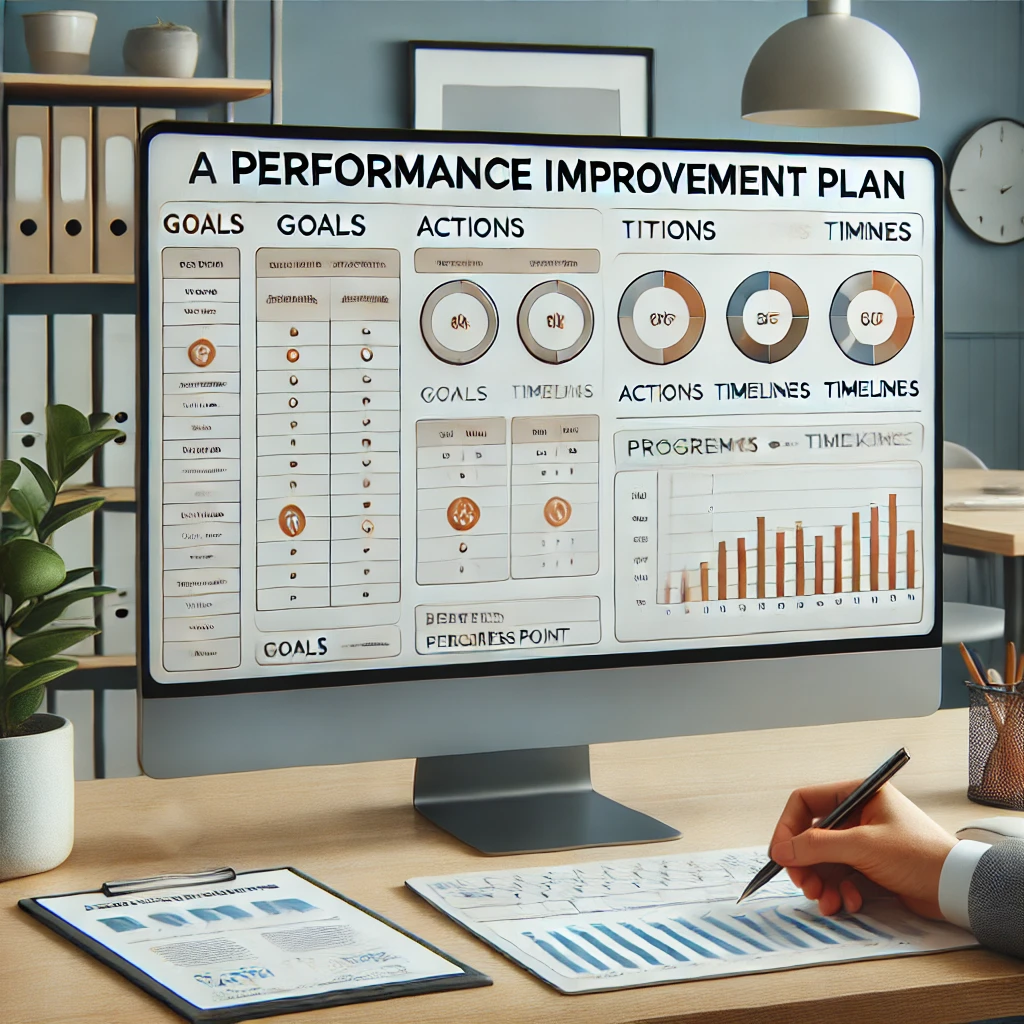Learn how to create an effective Performance Improvement Plan template with clear goals, actions, and timelines. Download our sample template to help manage employee performance efficiently.
Introduction
In any workplace, performance issues can arise that need to be addressed promptly and effectively. Whether it’s a dip in productivity, missed deadlines, or inadequate skills, helping an employee get back on track is critical. One of the most efficient ways to manage performance challenges is by using a Performance Improvement Plan (PIP). But how do you ensure the PIP process is structured, organized, and actionable? The answer is simple—a Performance Improvement Plan template.
In this article, we’ll dive into the key components of a PIP template, provide tips on how to create one, and offer a downloadable sample to help you manage employee performance more efficiently.
What is a Performance Improvement Plan Template?
A Performance Improvement Plan template is a pre-structured document designed to guide managers through the process of identifying, addressing, and improving an employee’s performance issues. It’s an essential tool for any HR professional or manager, offering a standardized way to document performance concerns and outline steps for improvement.
A good PIP template should:
- Clearly outline performance deficiencies.
- Set measurable, time-bound goals for improvement.
- Provide actionable steps and necessary resources for success.
- Track progress through regular reviews.
Benefits of Using a PIP Template
- Consistency: Using a template ensures that all employees are evaluated using the same criteria and processes, reducing bias.
- Clarity: Both managers and employees have a clear understanding of the expectations and steps involved in the improvement process.
- Efficiency: A pre-made template saves time and allows managers to focus on providing actionable feedback and guidance.
Key Elements of a Performance Improvement Plan Template
To create an effective PIP template, it’s important to include the following essential sections:
1. Employee Information
This section should include the employee’s name, job title, department, and the date the PIP is initiated. It’s also helpful to include the names of the manager and HR representative involved.
2. Performance Issues
Clearly outline the specific performance concerns that have led to the creation of the PIP. Avoid vague statements and instead focus on measurable aspects, such as:
- Failure to meet deadlines.
- Inconsistent quality of work.
- Lack of necessary skills for the role.
3. Goals and Expectations
This section should provide a list of measurable, specific goals the employee must achieve. Each goal should be tied to the identified performance issue and include:
- Specific Tasks: What exactly needs to be improved?
- Measurable Metrics: How will progress be evaluated?
- Achievable Targets: Set goals that are realistic and attainable.
- Relevant to Role: Ensure goals align with the employee’s job responsibilities.
- Time-Bound: Set a clear deadline for achieving these goals.
4. Action Steps
Provide a detailed action plan outlining the steps the employee must take to improve their performance. This could include:
- Training programs or additional courses.
- One-on-one coaching or mentoring.
- Adjustments to work processes.
5. Support and Resources
Make sure to offer the necessary resources and support to help the employee succeed. This could involve providing access to training, assigning a mentor, or offering additional tools to assist in their tasks.
6. Timeline
Define a specific timeline for the PIP. Typically, a PIP runs for 30, 60, or 90 days, depending on the complexity of the performance issues. Regular check-ins should be scheduled to monitor progress.
7. Progress Review and Feedback
Schedule regular performance reviews throughout the duration of the PIP. These check-ins allow for ongoing feedback and ensure that the employee stays on track.
8. Consequences
Clearly state what will happen if the employee fails to meet the PIP’s goals. Consequences may include further training, an extension of the PIP, or termination if no improvement is made.
How to Create a Performance Improvement Plan Template
Now that you know the essential elements, here’s how to create a performance improvement plan template from scratch:
Step 1: Set Clear Objectives
Define the purpose of the PIP template. Are you focusing on productivity, skills, or behavior? Setting clear objectives will guide the structure of the template.
Step 2: Structure the Template Logically
Organize the sections in a way that’s easy to follow. Begin with general information, then move into specific performance issues, followed by goals, actions, and support resources.
Step 3: Add Specific Details
Customize the template to fit your organization’s needs. Include fields for employee details, timelines, and the types of support provided.
Step 4: Create a Tracking System
Ensure the template includes a method for tracking progress, such as scheduled review dates and areas for managers to note feedback.
Step 5: Test and Refine
Before rolling out the template across your organization, test it with a small group to ensure it works effectively. Refine it based on feedback to ensure it’s practical and easy to use.
Sample Performance Improvement Plan Template
Here’s an example of a simple but effective performance improvement plan template. You can use this as a starting point and customize it to suit your needs.
| Employee Information |
|---|
| Employee Name |
| Job Title |
| Department |
| Manager |
| Date of Plan Initiation |
| Performance Issues |
|---|
| [Describe the specific performance issues in detail] |
| Goals & Expectations |
|---|
| Goal 1 |
| Goal 2 |
| Action Steps |
|---|
| Step 1 |
| Step 2 |
| Timeline |
|---|
| Start Date |
| End Date |
| Support Resources |
|---|
| [List resources such as training programs or coaching] |
| Progress Reviews |
|---|
| Check-in Date 1 |
| Check-in Date 2 |
| Consequences |
|---|
| [Describe what will happen if goals are not met] |
Conclusion
A well-designed Performance Improvement Plan template is a powerful tool for managers to help employees correct course, develop their skills, and meet performance expectations. By using a standardized PIP template, you can ensure clarity, fairness, and structure throughout the process, benefiting both the organization and the employee.
Whether you’re developing your own template or looking to refine an existing one, remember to focus on clear communication, measurable goals, and ongoing support. With the right plan in place, employee performance can improve significantly, leading to a more engaged and productive workforce.
FAQs about Performance Improvement Plan Templates
1. What should be included in a PIP template?
A PIP template should include employee information, specific performance issues, goals and expectations, action steps, support resources, a timeline, and scheduled reviews.
2. How long should a PIP last?
The length of a PIP can vary but is typically set for 30, 60, or 90 days, depending on the complexity of the performance issues.
3. Can a PIP lead to termination?
Yes, if an employee fails to meet the goals outlined in the PIP despite support and guidance, termination may be a potential consequence.
4. Is a PIP legally required?
No, a PIP is not legally required but is often used by companies to document performance issues and provide employees with a fair chance to improve.










